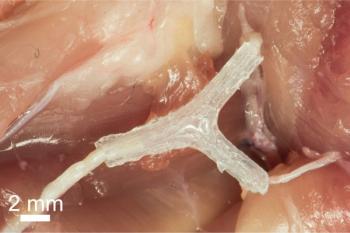HWN Jobs
- ACTION AGAINST HUNGER (OCTOBER) JOBS
- A REPUTABLE DIAGNOSTIC CENTRE JOBS
- HAYAT HOLDING (HAYAT KIMYA) JOBS
- PETRONOMICS LIMITED JOBS
- AFE BABALOLA UNIVERSITY, ADO EKITI (ABUAD) JOBS
HWN Blogs
- Classical heart healthy foods on HWN BLOGS
- Classical Warning Signs When The Human Liver Begins To Fail on HWN BLOGS
- Myths About Hygiene, Soaps, Germs, Sweat and Smell on HWN BLOGS
- Hernia does not heal on its own on HWN BLOGS
- Classical Essential Oils That Improves Focus Cum Memory on HWN BLOGS
news - Complex nerves regenerated with 3D technology on HWN MEDICAL INNOVATIONS back to all News
Complex nerves regenerated with 3D technology on HWN MEDICAL INNOVATIONS

Nerve regeneration is a complex process, which means that regrowth of nerves and regaining full motor sensory function after injury or disease is very rare. Nerve damage is often permanent. The new technique could help more than 200,000 people annually, following nerve injuries or disease, according to the new study, published in the journal Advanced Functional Materials.
Researchers used a combination of 3D imaging and 3D printing techniques to create a custom silicone guide implanted with biochemical cues to help regenerate complex nerves.
While regrowth of linear nerves has been achieved in the past, this is the first time a custom guide has been created in order to regrow a complex nerve - like the Y-shaped sciatic nerve - with both sensory and motor branches.
The guides effectiveness was tested in the lab using rats. The first step was to use a 3D scanner to reverse engineer the structure of a rat's sciatic nerve.
The team then used a specialized, custom-built 3D printer to print a guide for regeneration.
The guide, which incorporated 3D-printed chemical cues to promote motor and sensory nerve generation, was then implanted into the rat by surgically grafting it to the cut ends of the nerve.
Within about 10-12 weeks, the rat's ability to walk again was improved.
Scanning and printing takes about an hour, but it needs several weeks for the body to regrow the nerves. The next step would be to implant the guide into humans rather than rats, according to the lead researcher, Prof. Michael McAlpine, of the University of Minnesota Mechanical Engineering Department, who added:
Someday we hope that we could have a 3D scanner and printer right at the hospital to create custom nerve guides right on site to restore nerve function.
Prof. McAlpine proposes the development of a library of scanned nerves for cases where a nerve is unavailable for scanning. The data could be taken from other people or cadavers that hospitals could use to create closely matched 3D-printed guides for patients.
Alexandra Kingsbury, of the Commonwealth Scientific and Industrial Research Organization (CSIRO), Australia, who was recently involved in creating a 3D sternum and ribs device, as reported by Medical News Today, points out that 3D printing is especially relevant for medical application because it lends itself to complex or customized products.
She adds that 3D printing is a more expensive option than conventional manufacturing, but it is viable for low-volume runs, or in cases where an item is too complex to manufacture any other way. However, she notes that it will become more financially viable over time as productivity increases.
Source: Yvette Brazier, HWN Africa.
HWN News
- First Polish infant to survive on extreme dialysis on HWN MEDICAL MIRACLES
- Drug resistant tuberculosis end game on HWN INSIGHTS
- Too many women opting for caesarean sections (CS) to give birth on HWN SEX EDU
- The intelligent, strong and fearless Nurse that conquered Ebola on HWN ARCHIVE
- Medhi Benatia, down with injury on HWN SPORTS






